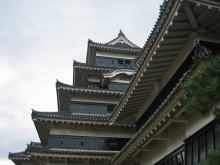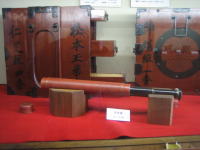|

Article in English
■石垣、石落しと狭間、武者窓■
城砦の天主部は敵に入り込まれたらおしまいです。そこで、接近する敵を迎撃・排撃するための仕組みがつくり込まれています。
まず石垣土塁。石垣や土塁に角や湾曲部が多いのは、「横矢掛」をつくり出すためです。横矢掛とは、石垣や土塁の頂角や突出部から弓や鉄砲による射撃をおこなって、接近を阻止するための装置です。
また一階の壁面は下に向かって広がっています。これを石落しと呼び、ここから直下に迫った敵に岩石などを投げ落とす仕組みです。
そして、すべての階の壁面の開口部はきわめて少なく、武者窓・格子窓や矢狭間や鉄砲狭間となっています。開口部から弓や鉄砲の射撃あるいは槍投げ落しをおこなうためのものです。
天主は非常にもっぱら戦うための施設ですから、日常行政や生活の場とすることができないほど殺伐としています。
防御態勢になったハリネズミのようなものです。
■武器庫としての天主群■
以上の理由からして、本丸天主群は非常時の武器庫なのです。平時には備えをしていても、機能していません。
そんなことのために、莫大な資源を投入して城郭を造営していたのです。松本城はいまだ戦国の世が続いていたときに建造されたので、外観の美しさにもかかわらず、とりわけ軍事施設としての性格が強いのです。
そんな歴史的背景のためか、天主はいまでは武器の展示場(資料館)となっています。数多くの火縄銃などの武器が陳列されています。
軍事施設としての天主の歴史的性格を展示する博物館としては、そうならざるをえません。

各種の火薬入れ
■防御濠と高い視座■
天主の高い構造は、戦況を判断するための高い視座を提供します。
高層の武者窓や狭間から見おろすと、堀が敵の接近や攻撃を阻む強固な障害となっていることがわかります。
城の高さと広い堀は、有効な防御装置なのです。

遠眼鏡
■防御性能と装飾性■
ところで、城郭、ことに天主は軍事装置なのだからもっぱら武骨でいいのかというと、そうでもなく、威厳や威信のために「見かけの優美」さも必要でした。
装飾性も高くないと、領主の権威、軍事装置としての威厳や威容を誇示できないからでしょう。
松本城は戦国末期に築城されましたが、後の城に受け継がれるはずの装飾性の高さ、優雅さも兼ね備えているのです。
そういうディスプレイとしての大天主屋根の鯱鉾や千鳥破風の装飾版の芯材なども展示されています。
■鎧武者スタッフ■
天主からの帰り道、鎧武者姿のスタッフが大天主をバックにしてポーズを取り、撮影機会をサービスしてくれました。
甲冑装備の重さを尋ねると「20kg以上はありますね」という答え。重い鎧を装着してこの広い本丸庭園を歩き、見学者にサービスするのは大変な仕事です。
|
